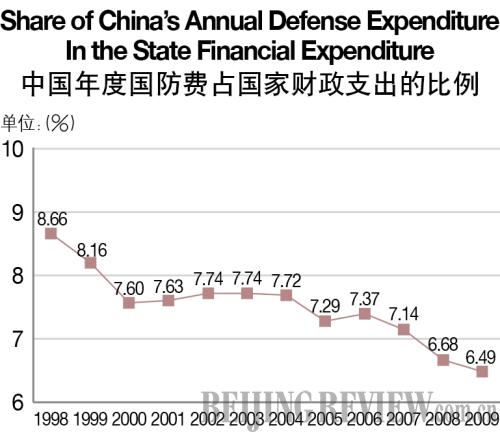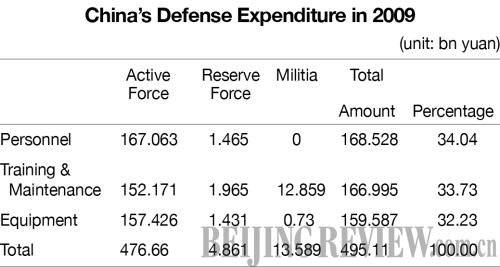| 

V. National Defense Mobilization and Reserve Force Building
China pursues the principles of combining peacetime needs with wartime needs, integrating military with civilian purposes and combining military efforts with civilian support. It strengthens national defense mobilization and reserve force building, enhances national defense mobilization capabilities, and reinforces its defense strength.
Organizational Structure and Leadership System of National Defense Mobilization
According to the Constitution and related laws, the Standing Committee of the National People's Congress (NPC) decides on general or partial mobilization. The president of the People's Republic of China, pursuant to the decisions of the Standing Committee of the NPC, issues mobilization orders. The State Council and the CMC work in combination to direct nationwide mobilization, formulate principles, policies and regulations, and organize the implementation of mobilization in accordance with the decisions of the Standing Committee of the NPC and mobilization orders issued by the president. When China's state sovereignty, national unification, territorial integrity or security are under imminent threat which requires an immediate action, the State Council and the CMC may take the necessary measures of national defense mobilization in response to the urgency and seriousness of the event, and at the same time report to the Standing Committee of the NPC.
Local people's governments organize and execute national defense mobilization within its administrative area in accordance with relevant principles, policies, laws and regulations. Related departments of local people's governments at and above the county level and those of the armed forces, within their respective scopes of duties, take charge of national defense mobilization work, and execute the programs and pre-arranged implementation plans.
At each level of the people's government from the county up to the state and in each military area command, there is a national defense mobilization commission. The State Commission for National Defense Mobilization, under the leadership of the State Council and the CMC, is in charge of organizing, directing and coordinating the nationwide national defense mobilization. The leaders of the State Council and the CMC take the positions of chairman and vice chairmen of the State Commission for National Defense Mobilization. Other members of the Commission include leaders of relevant ministries and commissions under the State Council, and leaders of the general headquarters/departments of the PLA. The core responsibilities of the Commission are to carry out the military strategy of active defense, organize and implement the state's defense mobilization, and coordinate relations between economic and military affairs, the armed forces and the government, and manpower and materials support in defense mobilization. Commissions for national defense mobilization of military area commands and local people's governments at and above county level are in charge of organizing, directing and coordinating national defense mobilization work within their respective jurisdictions. There are administrative offices in each commission for national defense mobilization to organize its routine work. At present, the State Commission for National Defense Mobilization has under its charge administrative offices responsible for the mobilization of the people's armed forces, national economy, civil air defense, transportation, and national defense education. The commissions in military area commands and local governments have under them corresponding offices.
In February 2010, the NPC Standing Committee passed the National Defense Mobilization Law of the People's Republic of China which specifies the peacetime preparations for and wartime implementation of national defense mobilization, stipulating the obligations and rights of each citizen and organization during mobilization and improving China's basic mobilization system.
National Defense Mobilization Capabilities Building
China's fundamental goal of strengthening defense mobilization is to establish and improve a mobilization system which is in line with national security demands, coordinated with the economic and social development and coupled with the emergency response mechanisms to increase mobilization capabilities. In recent years, following the principles of unified leadership, public participation, long-term preparations, priority to key projects, overall planning, all-round consideration, orderliness and high-efficiency, China has integrated its defense mobilization building with general social and economic development, gradually improving its capabilities in rapid mobilization, moving swiftly from a peacetime to wartime footing, and sustained support and comprehensive protection.
New progress has been made in people's armed forces mobilization. China has improved its plans for wartime troop mobilization and support, implemented pre-regimentation of reservists into active units, and strengthened the development of the reserve force. Based on possible wartime tasks and MOOTW demands, the militia force is improving its rapid mobilization process. The Law of the People's Republic of China on Reserve Officers, revised in August 2010, lays down new regulations on the authorities, procedures and methods of calling up reserve officers following a state decision to call for national defense mobilization.
Steady progress has been achieved in national economic mobilization. China has given priority to the requirements of national defense in building major infrastructure projects, and has continuously improved the compatibility of military and civilian key technologies and products. It has laid out a basic framework for generating capabilities in national economic mobilization, with key industries and major enterprises as the mainstay and important products and technologies as the links. China has made significant progress in the investigation of the potential of key areas, industries, technologies and products, further optimized the strategic reserve and storage system that meets defense requirements and economic growth, and caters to the needs of both emergencies and wars.
Progress has been accelerated in developing civil air defense (CAD). Adhering to the guidelines of long-term preparation, construction of key projects, and combination of needs in peacetime and war, China strives to do a better job in preparing against air raids in informationized conditions. There is an ongoing effort to improve the system of joint civil-military meetings and offices, optimizing the CAD organizations in local governments at and above county level and promoting the quasi-militarization of the CAD organs. Emphasis has been laid on the building of CAD command posts at all levels in accordance with the requirements of joint and regional air defense. Efforts have been made to improve CAD's disaster prevention functions and mechanisms featuring the combination of air defense with disaster prevention. More effort has been invested in providing protection for key economic targets, selected through evaluation and research. Emergency rescue and rapid repair plans have also been formulated in this regard. These CAD projects are incorporated into urban development plans and civil defense basements are incorporated in new buildings as required by law, meeting the requirements of the CAD in urban development, and balancing urban development and the CAD projects. Provinces, autonomous regions and municipalities have carried out extensive publicity campaigns, education programs and training initiatives to disseminate understanding of air defense and disaster prevention, skills of rescue and self-rescue, and methods of emergency evacuation.
Transportation mobilization for national defense is making steady and orderly progress. China is working to integrate combat-readiness as an element in the national transportation grid, and improve capabilities in strategic lines of communication support, strategic projection support, and rush transportation and rapid repair. Priority has been given to a number of projects that combine military and civilian purposes, giving impetus to an overall improvement in transportation combat-readiness for national defense. Relevant industries have helped in forming specialized support teams in an organic and systematic way, reinforcing transportation protection and communication maintenance along strategic lines of communication. Support plans for key communication targets and combat-readiness transportation have been formulated and revised, aimed at synchronized planning and construction of both military transportation facilities and urban development.
Reserve Force Building
With active servicemen as its backbone and reserve officers and men as its foundation, the reserve force is an armed force formed in line with the unified structure and organization of the PLA. It is under the dual leadership of the PLA and local Party committees and governments. The positions of chief military and political leaders at all levels and principal department leaders, as well as a proportion of the staff members and professionals and specialists, are assumed by active servicemen. Reserve officers are chosen mainly from qualified retired servicemen, civil officials, cadres of the people's armed forces departments, cadres of the militia and civilian technicians with the appropriate military specialties. Reserve soldiers are chosen mainly from qualified discharged soldiers, trained primary militia members, and civilians with the appropriate military specialties.
In recent years, the reserve force has undergone consistent improvement in various aspects of its building and reform. It works to improve its organizational models on a regional basis, to explore a systematic and organic organizational model based on new and hi-tech industries, and to develop such organizational models as personnel-and-equipment organization, trans-regional organization and community-based organization. Based on possible wartime assignments, the reserve force has revised and updated the guidelines for its military training and evaluation, strengthened integrated training with active PLA units, and conducted on-base, simulated and networked training. Reserve officers and men are required to devote 240 hours to political education and military training each year. To be able to respond to emergencies in peacetime and to fight in war, the focus of the reserve force is shifting from quantity and scale to quality and efficiency, from a combat role to a support role, and from the provision of general-purpose soldiers to soldiers with special skills. It is working to become an efficient auxiliary to the active force and a strong component of the national defense reserve.
Militia Force Building
The militia force is an important component of China's armed forces as well as the backup force of the PLA. In recent years, through transformation and reform, it has made progress in restructuring, in training reform, and in equipment building. China now has 8 million primary militia members.
The militia force gives priority to reinforcing those units which are tasked with defending border and coastal areas, providing service support for different arms and services, and responding in emergencies. It has been realigned to extend from rural to urban areas as well as to areas along important communication lines, from ordinary locations to key sites and areas, and from traditional industries to new and hi-tech ones. As a result, its structure and layout have been further improved. In line with the newly revised Outline for Military Training and Evaluation of the Militia, it promotes reforms in military training, holds joint training and exercises with active PLA units, improves the construction of associated training base facilities at all levels, and attaches importance to key detachment training. Its capabilities in dealing with both emergencies and wars have been greatly enhanced. The militia strengthens its building of equipment for the purposes of air defense, emergency response, and maintaining stability, supply of new types of air defense weaponry and equipment, and retrofitting and upgrading of existing weapons. There have been significant increases in the level of equipment-readiness and in the full kit rate.
The militia has taken an active part in such operations as counter-terrorism, stability maintenance, emergency rescue, disaster relief, border protection and control, and joint defense of public security, and has played a unique role in accomplishing diversified military tasks. Each year, it mobilizes more than 90,000 militiamen to serve as guards on bridges, tunnels and railways, more than 200,000 to take part in joint military-police-civilian defense patrols, more than 900,000 to participate in emergency response, rescue and relief operations following major natural disasters, and nearly 2 million to engage in the comprehensive control and management of social order in rural and urban areas.
|
